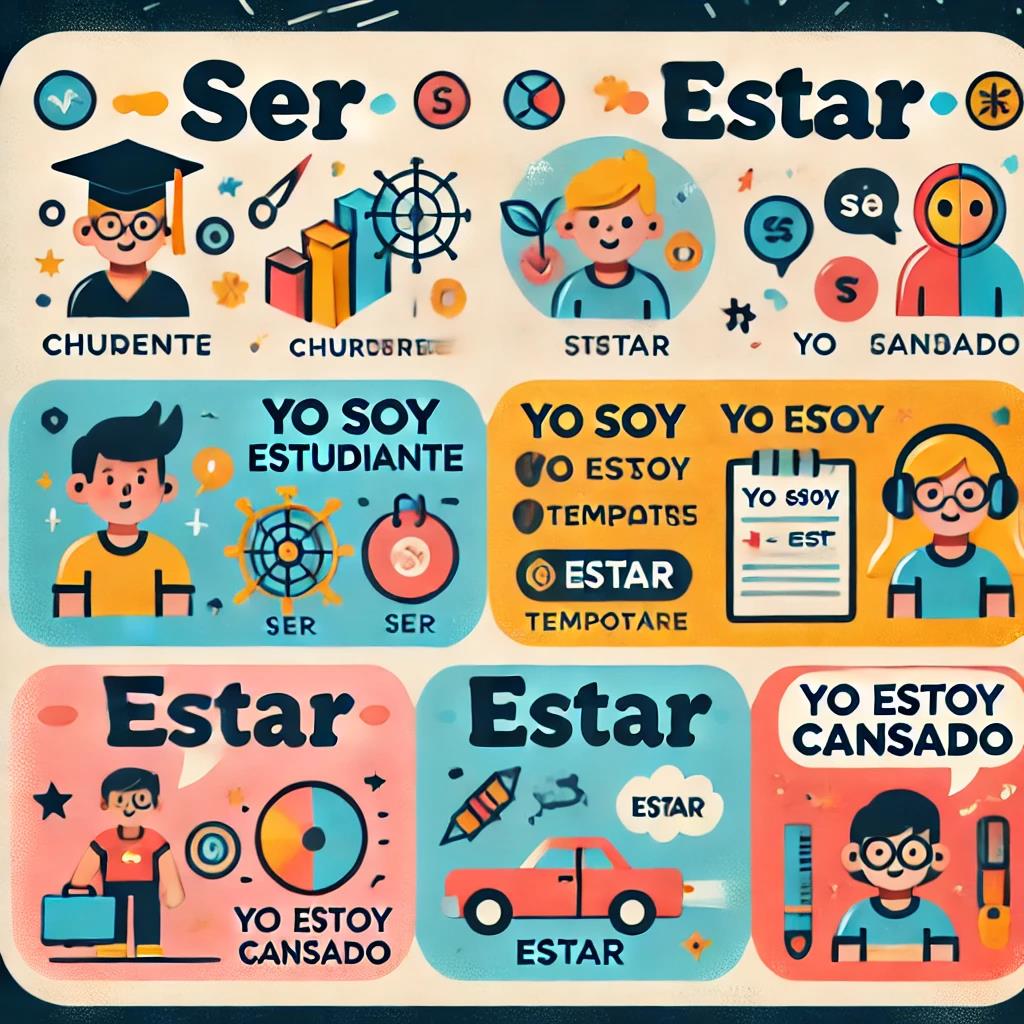SER vs. ESTAR: How to Remember When to Use Each
Tips to Remember When to Use Ser or Estar
SER and ESTAR are the two "to be" verbs in Spanish, and for English speakers, used just one verb, which can be confusing. But there is a way to understand these two verbs, by remembering DOCTOR and PLACE. This will help you remember when and how to use SER and ESTAR when learning Spanish.
How to Conjugate SER in the Present Tense
- Yo soy (I am).
- Tú eres (You are).
- Él es (He is).
- Ella es (She is)
- Vosotros sois (you are).
- Usted es (You are) – formal.
When to Use SER in Spanish
SER is used when discussing permanent states, we can remember with the acronym DOCTOR: Description, Occupation, Characteristic, Time, Origin, and Relation.
- Dates - "es el cinco de Mayo"
- Occupation - "es médico"
- Characteristics -"es alto y rubio"
- Time - "son las dos y media"
- Origin - "soy de España"
- Relation - "ella es mi hermana"
How to Conjugate ESTAR in the Present Tense
- Yo estoy (I am).
- Tú estás (You are).
- Él está (He is).
- Ella está (She is)
- Vosotros estáis (you plural)
- Usted está (You are) – formal.
When to Use ESTAR in Spanish
Estar refers primarily to how the object is and how it relates to a place or condition. Plus, its condition or location is often temporary. ESTAR is used when discussing permanent states, we can remember with the acronym PLACE.
- Position (above below etc): El sombrero está debajo de la mesa
- Location: Estoy en el supermercado, en el centro.
- Action: Estoy cocinando la cena
- Condition: el plato está roto
- Emotion: esta triste
Engaging Activities to Master SER and ESTAR in Spanish
To practise, try completing these sentences:
Ejemplos SER
- Hoy………… miercoles / …………….el 10 de agosto.
- Ella ………… artista/ ………………… deportista, juego al tenis.
- ¿………… (tu) alto?/ ………………… (ella) de Colombia
- ¿Que hora ……? / ……………… la una
- ¿De donde ………..(ellos)/ …………….. (yo) de Alemania
- ¿…….. la tia de Sabrina? …………………..tu libro?
Ejemplos ESTAR
- Mi libro ………………. delante de la televisión
- Columbia …………….. en America
- ……………….. (ellos) cocinando la cena
- El plato de pasta …………….. frio.
- ………………………(yo) muy feliz.

Completa: SER or ESTAR
Now try to figure out which form you need for these:
- Luis __________ médico y Susana __________ secretaria.
- Nosotros __________ simpáticos.
- Los niños __________ pequeños y ahora __________ en la escuela.
- ¿Dónde __________ el libro? El libro __________ en la mesa.
- La casa __________ grande y bonita, pero __________ sucia.
- Rosa __________ en casa.
- ¿Qué hora __________? __________ las siete.
- La cafetera __________ rota, hoy no podemos tomar café.
- Javier __________ en la playa con mi hermano y con mi tío.
- Vosotras __________ inteligentes, altas, guapas y elegantes.
- Berlín __________ en Alemania y Madrid __________ en España.
- La bicicleta de María __________ roja y la de Juan __________ azul.
- Tú __________ el dueño de la zapatería y yo __________ un dependiente.
- ¿Dónde __________ el gato? Él __________ en la calle.
- Mi cuñado __________ carpintero y mi sobrino __________ mecánico.
- Nuestro profesor __________ enfermo de apendicitis.
- ¿Tú __________ protestante o católico?
- El Ayuntamiento __________ a la izquierda de la plaza.
- Alberti y Guillén __________ dos grandes poetas españoles.
- ¿Quién de ustedes __________ el electricista?
- Acapulco __________ una gran ciudad que __________ en México.
- ¿Qué día __________ hoy? -Miércoles, 20 de mayo.
- Pedro y tú __________ rubios y ellos __________ morenos.
SER vs ESTAR: How Meaning Changes Depending on the Form
There are instances where you can use both forms, and it would change the meaning. See the following:
This is one of the most common causes of confusion for English speakers, as you only have one: to be.
It needs quite a lot of practice to master it, so don't worry if you don't get it the first time (or the second time).
Nevertheless, it is necessary to keep practising, as sometimes using the wrong verb can change the meaning of the sentence completely!
Have a look at these two sentences and see how the meaning changes:
- Miguel es bueno.
Miguel is good. [i.e. Miguel is a good boy-person.] - Miguel está bueno.
Miguel is "hot". [i.e. Miguel is cute.]
Mastering when and how to use SER and ESTAR becomes much easier with consistent practice. To ace tricky topics like these, finding a Spanish tutor is highly recommended. Hope this has been helpful!


